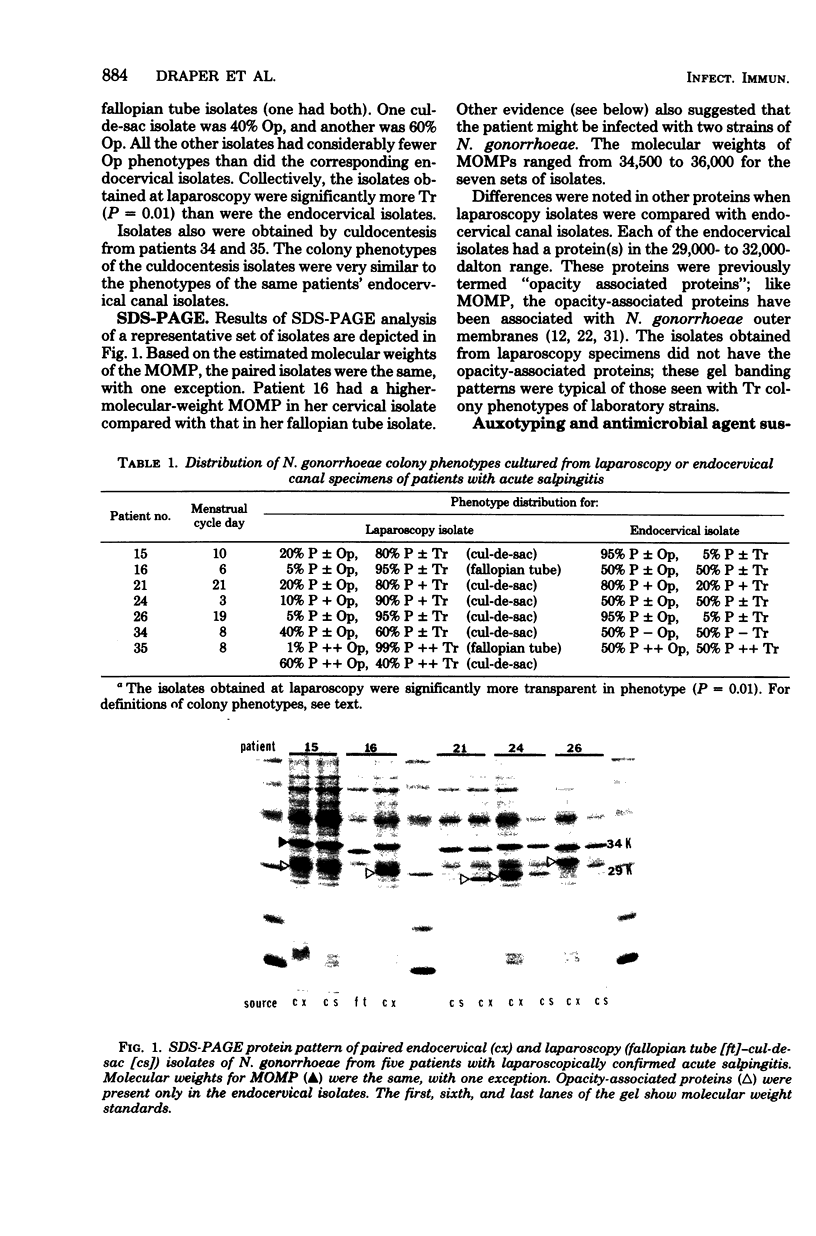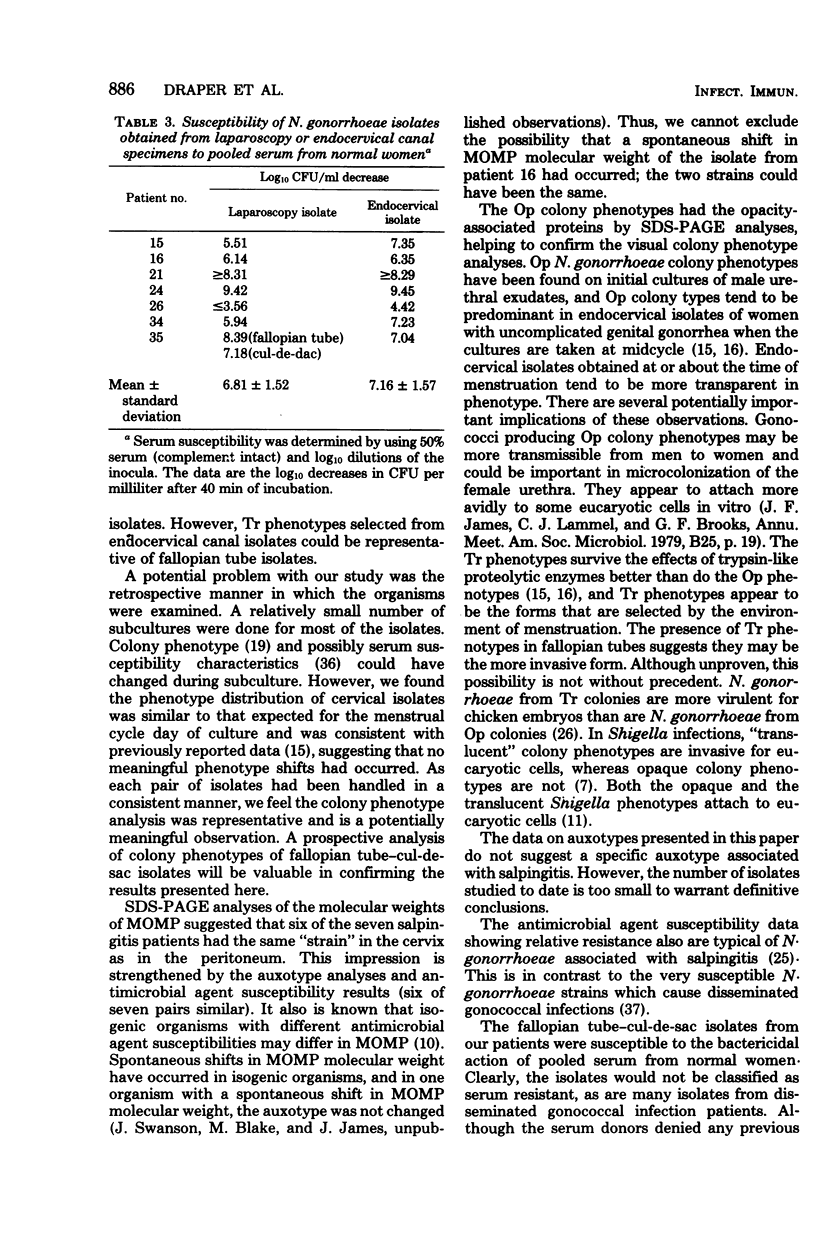Abstract
Neisseria gonorrhoeae strains which cause acute salpingitis are presumed to ascend the genital tract from the cervix. Previous studies utilized isolates obtained from endocervical canal cultures, although it was not known if the isolates truly represented the organisms present in the fallopian tubes. In this study, we compared N. gonorrhoeae isolates from endocervical canal cultures with fallopian tube or peritoneal cul-de-sac isolates or isolates from both sites obtained at laparoscopy. Potential virulence markers were studied, including colony phenotype, auxotype, antimicrobial agent susceptibility, protein patterns on sodium dodecyl sulfate-polyacrylamide gel electrophoresis, and susceptibility to normal human serum. Six of seven cervical isolates had the same antibiograms and molecular weight for major outer membrane proteins as those of the corresponding peritoneal isolates. Auxotypes also were the same and included prototrophic, proline-requiring, and proline-and-arginine-requiring isolates. The isolates as a group appeared to be very susceptible to the bactericidal action of pooled serum from normal women. Colony phenotypes varied between sites; the fallopian tubecul-de-sac isolates were predominantly of transparent phenotype and piliated. The cervical isolates were either mixtures of equal quantities of opaque and transparent phenotypes or predominantly opaque phenotype. By these markers, patients' N. gonorrhoeae cervical isolates appeared to be the same as their isolates from fallopian tubes except for a difference or shift in colony phenotype.
Full text
PDF






Images in this article
Selected References
These references are in PubMed. This may not be the complete list of references from this article.
- Brooks G. F., Ingwer I. Studies on the relationships between serum bactericidal activity and uncomplicated genital infections due to Neisseria gonorrhoeae. J Infect Dis. 1978 Sep;138(3):333–339. doi: 10.1093/infdis/138.3.333. [DOI] [PubMed] [Google Scholar]
- Brooks G. F., Israel K. S., Petersen B. H. Bactericidal and opsonic activity against Neisseria gonorrhoeae in sera from patients with disseminated gonococcal infection. J Infect Dis. 1976 Nov;134(5):450–462. doi: 10.1093/infdis/134.5.450. [DOI] [PubMed] [Google Scholar]
- Carifo K., Catlin B. W. Neisseria gonorrhoeae auxotyping: differentiation of clinical isolates based on growth responses on chemically defined media. Appl Microbiol. 1973 Sep;26(3):223–230. doi: 10.1128/am.26.3.223-230.1973. [DOI] [PMC free article] [PubMed] [Google Scholar]
- Eschenbach D. A. Acute pelvic inflammatory disease: etiology, risk factors and pathogenesis. Clin Obstet Gynecol. 1976 Mar;19(1):147–169. doi: 10.1097/00003081-197603000-00013. [DOI] [PubMed] [Google Scholar]
- Faur Y. C., Weisburd M. H., Wlson M. E., May P. S. NYC medium for simultaneous isolation of Neisseria gonorrhoeae, large-colony mycoplasmas, and T-mycoplasmas. Appl Microbiol. 1974 Jun;27(6):1041–1045. doi: 10.1128/am.27.6.1041-1045.1974. [DOI] [PMC free article] [PubMed] [Google Scholar]
- Hale T. L., Bonventre P. F. Shigella infection of Henle intestinal epithelial cells: role of the bacterium. Infect Immun. 1979 Jun;24(3):879–886. doi: 10.1128/iai.24.3.879-886.1979. [DOI] [PMC free article] [PubMed] [Google Scholar]
- Heckels J. E. The surface of Neisseria gonorrhoeae: isolation of the major components of the outer membrane. J Gen Microbiol. 1977 Apr;99(2):333–341. doi: 10.1099/00221287-99-2-333. [DOI] [PubMed] [Google Scholar]
- Hildebrandt J. F., Mayer L. W., Wang S. P., Buchanan T. M. Neisseria gonorrhoeae acquire a new principal outer-membrane protein when transformed to resistance to serum bactericidal activity. Infect Immun. 1978 Apr;20(1):267–272. doi: 10.1128/iai.20.1.267-272.1978. [DOI] [PMC free article] [PubMed] [Google Scholar]
- James J. F., Swanson J. Studies on gonococcus infection. XIII. Occurrence of color/opacity colonial variants in clinical cultures. Infect Immun. 1978 Jan;19(1):332–340. doi: 10.1128/iai.19.1.332-340.1978. [DOI] [PMC free article] [PubMed] [Google Scholar]
- Kasper D. L., Rice P. A., McCormick W. M. Bactericidal antibody in genital infection due to Neisseria gonorrhoeae. J Infect Dis. 1977 Feb;135(2):243–251. doi: 10.1093/infdis/135.2.243. [DOI] [PubMed] [Google Scholar]
- Kellogg D. S., Jr, Cohen I. R., Norins L. C., Schroeter A. L., Reising G. Neisseria gonorrhoeae. II. Colonial variation and pathogenicity during 35 months in vitro. J Bacteriol. 1968 Sep;96(3):596–605. doi: 10.1128/jb.96.3.596-605.1968. [DOI] [PMC free article] [PubMed] [Google Scholar]
- Knapp J. S., Holmes K. K. Disseminated gonococcal infections caused by Neisseria gonorrhoeae with unique nutritional requirements. J Infect Dis. 1975 Aug;132(2):204–208. doi: 10.1093/infdis/132.2.204. [DOI] [PubMed] [Google Scholar]
- Laemmli U. K. Cleavage of structural proteins during the assembly of the head of bacteriophage T4. Nature. 1970 Aug 15;227(5259):680–685. doi: 10.1038/227680a0. [DOI] [PubMed] [Google Scholar]
- McCutchan J. A., Levine S., Braude A. I. Influence of colony type on susceptibility of gonococci to killing by human serum. J Immunol. 1976 Jun;116(6):1652–1655. [PubMed] [Google Scholar]
- Provonchee R. B., Zinner S. H. Rapid method for determining serum bactericidal activity. Appl Microbiol. 1974 Jan;27(1):185–186. doi: 10.1128/am.27.1.185-186.1974. [DOI] [PMC free article] [PubMed] [Google Scholar]
- Salit I. E., Gotschlich E. C. Gonococcal color and opacity variants: virulence for chicken embryos. Infect Immun. 1978 Nov;22(2):359–364. doi: 10.1128/iai.22.2.359-364.1978. [DOI] [PMC free article] [PubMed] [Google Scholar]
- Schoolnik G. K., Buchanan T. M., Holmes K. K. Gonococci causing disseminated gonococcal infection are resistant to the bactericidal action of normal human sera. J Clin Invest. 1976 Nov;58(5):1163–1173. doi: 10.1172/JCI108569. [DOI] [PMC free article] [PubMed] [Google Scholar]
- Swanson J. Studies on gonococcus infection. XII. Colony color and opacity varienats of gonococci. Infect Immun. 1978 Jan;19(1):320–331. doi: 10.1128/iai.19.1.320-331.1978. [DOI] [PMC free article] [PubMed] [Google Scholar]
- Swanson J. Studies on gonococcus infection. XVIII. 125I-labeled peptide mapping of the major protein of the gonococcal cell wall outer membrane. Infect Immun. 1979 Mar;23(3):799–810. doi: 10.1128/iai.23.3.799-810.1979. [DOI] [PMC free article] [PubMed] [Google Scholar]
- Sweet R. L., Mills J., Hadley K. W., Blumenstock E., Schachter J., Robbie M. O., Draper D. L. Use of laparoscopy to determine the microbiologic etiology of acute salpingitis. Am J Obstet Gynecol. 1979 May 1;134(1):68–74. doi: 10.1016/0002-9378(79)90798-1. [DOI] [PubMed] [Google Scholar]
- Thompson S. E., Reynolds G., Short H. B., Thornsberry C., Biddle J. W., Jacobs N. F., Rein M. F., Zaidi A., Young F. E., Shulman J. A. Auxotypes and antibiotic susceptibility patterns of Neisseria gonorrhoeae from disseminated and local infections. Sex Transm Dis. 1978 Oct-Dec;5(4):127–131. doi: 10.1097/00007435-197810000-00001. [DOI] [PubMed] [Google Scholar]
- Tramont E. C., Sadoff J. C., Wilson C. Variability of the lytic susceptibility of Neisseria gonorrhoeae to human sera. J Immunol. 1977 May;118(5):1843–1851. [PubMed] [Google Scholar]
- Ward M. E., Watt P. J., Glynn A. A. Gonococci in urethral exudates possess a virulence factor lost on subculture. Nature. 1970 Jul 25;227(5256):382–384. doi: 10.1038/227382a0. [DOI] [PubMed] [Google Scholar]
- Wiesner P. J., Handsfield H. H., Holmes K. K. Low antibiotic resistance of gonococci causing disseminated infection. N Engl J Med. 1973 Jun 7;288(23):1221–1222. doi: 10.1056/NEJM197306072882308. [DOI] [PubMed] [Google Scholar]



